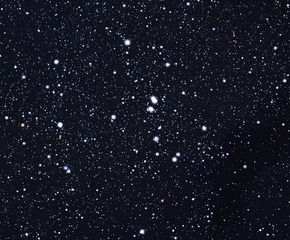NGC 6871
Appearance
| NGC 6871 | |
|---|---|
 NGC 6871, taken from Stellarium | |
| Observation data (J2000 epoch) | |
| Right ascension | 20h 05m 59s[1] |
| Declination | +35° 46.6′[1] |
| Distance | 5133 ly (1574 pc[2]) |
| Apparent magnitude (V) | 5.2[3] |
| Physical characteristics | |
| Estimated age | 9.1 million years |
| Presence of eclipsing binary stars [4] | |
| Other designations | GC 4548, h 2067, Struve 2630[3] |
| Associations | |
| Constellation | Cygnus |
NGC 6871 is a small, young open cluster in the constellation of Cygnus. The cluster has fewer than 50 members, most of which are blue and white stars. It is located 5135 light-years from Earth.

NGC 6871 was born in the same giant molecular cloud with at least six other open clusters. The other open clusters are not gravitationally associated with NGC 6871. NGC 6871 itself also seems to be disintegrating.[5]
| Star name | Effective temperature | Absolute magnitude | Bolometric magnitude | Mass (M☉) | Spectral type | Ref. |
|---|---|---|---|---|---|---|
| HD 190864 | 39900 | -5.5 | -9.3 | 45 | O7III | [6] |
| HD 226868 | 33000 | -6.4 | -9.6 | 40 | O9.7I | [6] |
| HD 227018 | 41000 | -4.9 | -8.8 | 38 | O7V | [6] |
| HD 191201 | 31600 | -5.8 | -8.9 | 35 | B0V | [6] |
| WR 133 A | 70800 | -3.4 | -8.81 | 9.3 | WN5o | [6][7] |
| ADS 13374 B (Companion to WR 133 A, also WR 133 B) | 30000 | -5.4 | -8.49 | 22.6 | O9.5I | [6][7] |
| HD 227634 | 29500 | -5.3 | -8.2 | 25 | B0.2III | [6] |
| HD 190919 | 26300 | -5.8 | -8.3 | 25 | B1Ib | [6] |
| BD+35 3955 | 26300 | -5.7 | -8.3 | 24 | B1Ib | [6] |
References
- ^ a b "NGC 6871". SIMBAD. Centre de données astronomiques de Strasbourg. Retrieved 2012-09-21.
- ^ "Results for NGC 6871". WEBDA Database. Retrieved 2012-09-21.
- ^ a b "Results for NGC 6871". SEDS' Interactive NGC Catalog Online. Retrieved 2012-09-21.
- ^ "Astronomy Magazine". NGC 6871 - open cluster in Cygnus. Retrieved 2015-08-18.
- ^ Casado, Juan; Hendy, Yasser (2023). "Discovery and description of two young open clusters in the primordial group of NGC 6871". Monthly Notices of the Royal Astronomical Society. 521 (1): 1399–1407. arXiv:2211.12843. Bibcode:2023MNRAS.521.1399C. doi:10.1093/mnras/stad071.
- ^ a b c d e f g h i Massey, P.; Degioia-Eastwood, K.; Waterhouse, E. (2001). "The Progenitor Masses of Wolf-Rayet Stars and Luminous Blue Variables Determined from Cluster Turnoffs. II. Results from 12 Galactic Clusters and OB Associations". The Astronomical Journal. 121 (2): 1050–1070. arXiv:astro-ph/0010654. Bibcode:2001AJ....121.1050M. doi:10.1086/318769. S2CID 53345173.
- ^ a b Richardson, Noel D.; Lee, Laura; Schaefer, Gail; Shenar, Tomer; Sander, Andreas A. C.; Hill, Grant M.; Fullard, Andrew G.; Monnier, John D.; Anugu, Narsireddy; Davies, Claire L.; Gardner, Tyler (2021-02-01). "The First Dynamical Mass Determination of a Nitrogen-rich Wolf-Rayet Star Using a Combined Visual and Spectroscopic Orbit". The Astrophysical Journal Letters. 908 (1): L3. arXiv:2101.04232. Bibcode:2021ApJ...908L...3R. doi:10.3847/2041-8213/abd722. ISSN 0004-637X. S2CID 231582956.
External links
 Media related to NGC 6871 at Wikimedia Commons
Media related to NGC 6871 at Wikimedia Commons- NGC 6871 at WEBDA
- NGC 6871 at Bernhard Hubl's Astrophotography
- NGC 6871 at Astronomy Magazine
